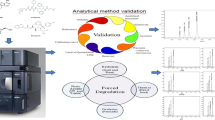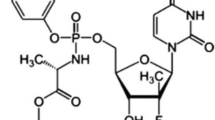Abstract
A simple, precise, and rapid method to simultaneously determine the levels of oseltamivir (OS) and oseltamivir carboxylate (OSC) in human plasma was developed. Additionally, the stability of both substances in plasma was investigated under different conditions. The method involved protein precipitation (0.01 % HCl in acetonitrile), and then the supernatant was injected into the high-performance liquid chromatography (HPLC)-MS/MS. The chromatographic separation was achieved on a YMC-Triart C18 (100 × 2.0 mm, 5 μm) column using acetonitrile/water (30:70, v/v) containing 0.1 % formic acid as the mobile phase. Sample volume was 5 μl. The linearity of the method was established in the concentration range of 0.5–100 ng/mL for OS and 1.0–1000 ng/mL for OSC. The intra-day precision and accuracy for oseltamivir were 1.5–8.9 and 94.4–101.0 %, respectively. For oseltamivir carboxylate, the intra-day precision and accuracy were 3.2–12.7 and 92.8–108.8 %, respectively, whereas the inter-day precision and accuracy were 5.5–11.5 and 94.6–104.0 % for oseltamivir and 4.7–11.5 and 99.9–103.9 % for oseltamivir carboxylate, respectively. The application of this method was demonstrated by a bioequivalence study in 28 healthy humans with 75 mg oseltamivir phosphate capsules (Tamiflu®). Sodium fluoride (2.4 mg/mL) with potassium oxalate (3 mg/mL) was used as anticoagulant within sampling of trial. The assay reproducibility was established by reanalysis of 80 incurred samples.



Similar content being viewed by others
References
Moscona A. Neuraminidase inhibitors for influenza. New Engl J Med. 2005;353:1363–73.
He G, Massarella J, Ward P. Clinical pharmacokinetics of the prodrug oseltamivir and its active metabolite Ro 64-0802. Clin Pharmacokinet. 1999;37:471–84.
Massarella JW, He GZ, Dorr A, Nieforth K, Ward P, Brown A. The pharmacokinetics and tolerability of the oral neuraminidase inhibitor oseltamivir (Ro 64-0796/GS4104) in healthy adult and elderly volunteers. Eur J Clin Pharmacol. 2000;40:836–43.
Schentag JJ, Hill G, Chu T, Rayner CR. Similarity in pharmacokinetics of oseltamivir and oseltamivir carboxylate in Japanese and Caucasian subjects. J Clin Pharmacol. 2007;47:689–96.
Gupta A, Guttikar S, Shrivastav PS, Sanyal M. Simultaneous quantification of prodrug oseltamivir and its metabolite oseltamivir carboxylate in human plasma by LC–MS/MS to support a bioequivalence study. J Pharm Anal. 2013;3(3):149–60.
Kromdijk W, Rosing H, Broek MP, Beijnen JH, Huitema AD. Quantitative determination of oseltamivir and oseltamivir carboxylate in human fluoride EDTA plasma including the ex vivo stability using high-performance liquid chromatography coupled with electrospray ionization tandem mass spectrometry. J Chromatogr B. 2012;891–892:57–63.
Hu Z-Y, Laizure SC, Meibohm B, Herring VL, Parker RB. Simple and sensitive assay for quantification of oseltamivir and its active metabolite oseltamivir carboxylate in human plasma using high-performance liquid chromatography coupled with electrospray ionization tandem mass spectrometry: improved applicability to pharmacokinetic study. J Pharm Biomed Anal. 2013;72:245–50.
Kanneti R, Bhavesh D, Paramar D, Bhatt SR. Development and validation of a high throughput and robust LC-MS/MS with electrospray ionization method for simultaneous quantitation of oseltamivir phosphate and its oseltamivir carboxylate metabolite in human plasma for pharmacokinetic studies. Biomed Chromatogr. 2011;25:727–33.
Lindegardh N, Hanpithakpong W, Wattanagoon Y, Singhasivanon P, White NJ, Day NP. Development and validation of a liquid chromatographic tandem mass spectrometric method for determination of oseltamivir and its metabolite oseltamivir carboxylate in plasma, saliva and urine. J Chromatogr B. 2007;859:74–83.
Wiltshire H, Wiltshire B, Citron A, Clarke T, Serpe C, Gray D, et al. Development of a high-performance liquid chromatographic-mass spectrometric assay for the specific and sensitive quantification of Ro 64-0802, an anti-influenza drug, and its pro-drug, oseltamivir, in human and animal plasma and urine. J Chromatogr B. 2000;745:373–88.
Heinig K, Wirz T, Bucheli F, Gajate-Perez A. Determination of oseltamivir (Tamiflu) and oseltamivir carboxylate in dried blood spots using offline or online extraction. Bioanalysis. 2011;3:421–37.
Lindegardh N, Davies GR, Hien TT, Farrar J, Singhasivanon P, Day NPJ, et al. Rapid degradation of oseltamivir phosphate in clinical samples by plasma esterases. Antimicrob Agents Chemother. 2006;50(9):3197–9.
Lindegardh N, Davies GR, Hien TT, Farrar J, Singhasivanon P, Day NPJ, et al. Importance of collection tube during clinical studies of oseltamivir. Antimicrob Agents Chemother. 2007;51(5):1835–6.
Mohri M, Allahyari L, Sardari K. Effects of common anticoagulants on routine plasma biochemistry of horse and comparison with serum. J Equine Vet Sci. 2007;27(7):313–6.
Barri T, Dragsted LO. UPLC-ESI-QTOF/MS and multivariate data analysis for blood plasma and serum metabolomics: effect of experimental artefacts and anticoagulant. Anal Chim Acta. 2013;768:118–28.
Guideline on bioanalytical method validation. European Medicines Agency. Committee for Medicinal Products for Human Use (CHMP). 2011.
Yaroshenko DV, Grigoriev AV, Sidorova AA. Development and validation of a LC-MS/MS method for d-cycloserine determination in human plasma for bioequivalence study. Anal Bioanal Chem. 2014;406(3):923–7.
World Medical Association Declaration of Helsinki—Ethical principles for medical research involving human subjects. Adopted by the 18th WMA General Assembly Helsinki, Finland, June 1964 and amended by the 59th WMA General Assembly, Seoul, October 2008, Available from: http://www.wma.net/en/30publications/10policies/b3/17c.pdf
Acknowledgments
This study was performed using the labware of the Research Center “Nanotechnology,” at Peter the Great St. Petersburg Polytechnic University, Russia.
Author information
Authors and Affiliations
Corresponding author
Ethics declarations
Informed Consent
The informed consent was obtained by all volunteers. The study had been approved by the local ethics committee and performed in accordance with ethical standards and the legislation.
Conflict of interest
The authors declare that they have no conflict of interest.
Rights and permissions
About this article
Cite this article
Grigoriev, A., Borisova, I., Yaroshenko, I. et al. In vitro and in vivo stability of oseltamivir within a bioequivalence trial. Anal Bioanal Chem 408, 3891–3897 (2016). https://doi.org/10.1007/s00216-016-9483-2
Received:
Revised:
Accepted:
Published:
Issue Date:
DOI: https://doi.org/10.1007/s00216-016-9483-2




